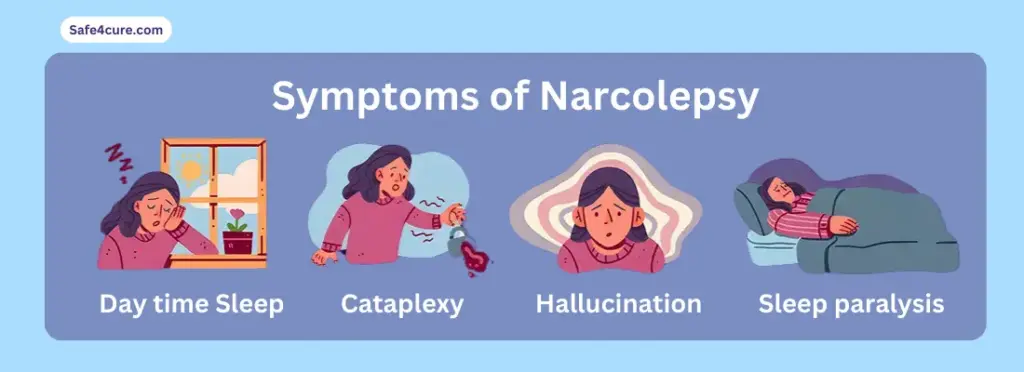Introduction to Narcolepsy
Narcolepsy is a chronic neurological disorder that disrupts the brain’s ability to regulate sleep-wake cycles. Affecting approximately 1 in 2,000 people worldwide, it’s characterized by excessive daytime sleepiness (EDS), sudden sleep attacks, and disrupted nighttime sleep. Despite its prevalence, narcolepsy is often misunderstood, leading to delayed diagnosis and stigma. This guide explores the science, symptoms, and strategies for managing narcolepsy to empower patients and caregivers.
What is Narcolepsy?
Narcolepsy is more than just feeling tired—it’s a chronic neurological disorder where your brain can’t control your ability to sleep or stay awake characterized by excessive daytime sleepiness and an inability to regulate sleep-wake cycles. People with this condition often fall asleep during the day, along with other symptoms. Symptoms are rooted in the brain due to the loss of hypocretin (orexin), a brain chemical that stabilizes wakefulness and REM sleep. There are two types of Narcolepsy :
- Type 1 Narcolepsy (with cataplexy): Involves sudden muscle weakness triggered by emotions.
- Type 2 Narcolepsy (without cataplexy): Presents excessive daytime sleepiness but do not have cataplexy. (no muscle weakness).
This condition significantly impacts daily life, from work performance to emotional well-being. Early diagnosis and tailored treatment are critical for improving outcomes.
Symptoms of Narcolepsy

Narcolepsy is a long-term sleep disorder. Once it develops, it doesn’t go away completely. It affects the brain’s ability to control sleep and wake cycles. People with narcolepsy often struggle to stay awake during the day and may suddenly fall asleep without warning. This can interfere with daily life, work, school, and relationships. Because the symptoms can look like other health problems, narcolepsy is often misunderstood or missed. Understanding the common signs can help with early diagnosis and better treatment.
Recognizing narcolepsy’s symptoms is the first step toward diagnosis. Key signs include:
1. Excessive Daytime Sleepiness (EDS)
This is the most common and noticeable symptom of narcolepsy. People with EDS feel extremely tired during the day, even after getting enough sleep at night. They may struggle to stay awake at work, in class, or while driving. Sometimes, they suddenly fall asleep without warning, even in the middle of a conversation or activity. This constant sleepiness can make it hard to focus, stay alert, or enjoy daily life.
2. Cataplexy (Type 1 Only)
Cataplexy is a sudden, brief loss of muscle control that happens while you’re awake. It’s usually triggered by strong emotions like laughter, excitement, fear, or anger. During an episode, your knees might buckle, your head may drop, or you could even collapse, but you stay fully awake and aware. The episodes usually last a few seconds to a couple of minutes and go away on their own. Cataplexy only happens in Type 1 narcolepsy and is a key sign doctors look for when diagnosing this type.
3. Sleep Paralysis
Sleep paralysis is when you wake up or are falling asleep and can’t move your body or speak for a short time. Even though you’re awake and aware of what’s happening, your body feels frozen. These episodes usually last only a few seconds to a couple of minutes but can be very frightening. Some people may also feel pressure on their chest or have trouble breathing. Sleep paralysis is harmless, but it can be a scary experience, especially if it happens often.
4. Hypnagogic/Hypnopompic Hallucinations
These are vivid dream-like experiences that happen as you’re falling asleep (hypnagogic) or waking up (hypnopompic). You might see, hear, or even feel things that aren’t really there—like someone talking to you, a shadowy figure in the room, or a strange sound. These hallucinations can feel very real and are often frightening or confusing. They happen because the brain starts dreaming before you’re fully asleep or stays in dream mode as you wake up.
5. Disrupted Nighttime Sleep
People with narcolepsy feel very sleepy during the day, they often have trouble sleeping well at night. Their sleep can be light, restless, and broken by frequent awakenings. They may wake up several times during the night and have trouble falling back asleep. This poor nighttime sleep makes daytime sleepiness worse and adds to the overall tiredness and fatigue narcolepsy causes.
Less Common Symptoms:
Along with the main symptoms, some people with narcolepsy may experience other less common signs.
- Automatic behaviors (e.g., continuing tasks while asleep).
- Memory lapses or brain fog.
Causes and Risk Factors
The exact cause of narcolepsy remains unclear, but research highlights several factors:
1. Loss of Hypocretin Neurons
- Type 1 narcolepsy is linked to the destruction of hypocretin-producing cells in the hypothalamus, likely due to an autoimmune response.
2. Genetic Predisposition
- Certain genes, like HLA-DQB1*06:02, increase susceptibility.
- Only 1-2% of people with these genes develop narcolepsy, suggesting environmental triggers.
3. Triggers
- Infections (e.g., H1N1 influenza, streptococcal).
- Hormonal changes (puberty, menopause).
- Trauma or psychological stress.
Diagnosing Narcolepsy
Diagnosing narcolepsy can take time because its symptoms can look like other sleep problems or health conditions. If a doctor thinks you might have narcolepsy, they will usually refer you to a sleep specialist for further testing.
Diagnosis involves clinical evaluation and specialized tests:
1. Medical History and Symptom Assessment
The doctor will ask detailed questions about your sleep habits, daytime drowsiness, and any unusual experiences like muscle weakness or sleep paralysis. You may be asked to keep a sleep diary for a couple of weeks to track your sleep patterns.
2. Polysomnography (PSG)
An overnight sleep study done in a sleep lab that monitors your brain waves, breathing, heart rate, and body movements while you sleep.
3. Multiple Sleep Latency Test (MSLT)
- Measures how quickly a patient falls asleep during daytime naps.
- A mean sleep latency of ≤8 minutes and ≥2 REM episodes suggest narcolepsy.
4. Hypocretin Testing
- Cerebrospinal fluid analysis detects low hypocretin levels (Type 1).
Challenges: Misdiagnosis is common due to overlapping symptoms with depression or epilepsy.
Treatment Options for Narcolepsy
While there is no cure for narcolepsy, the symptoms can be managed with the right combination of medication, lifestyle changes, and supportive care. The goal of treatment is to reduce daytime sleepiness, prevent sudden sleep attacks, and improve overall quality of life.
1. Medications
Doctors may prescribe different types of medicines depending on your symptoms:
- Stimulants: Modafinil or armodafinil promote wakefulness.
- Sodium Oxybate: Improves nighttime sleep and reduces cataplexy.
- Antidepressants: SSRIs/SNRIs (e.g., venlafaxine) suppress REM-related symptoms.
2. Lifestyle Adjustments
Making small changes to your daily routine can help manage narcolepsy better:
- Scheduled Naps: 20-minute naps boost alertness.
- Sleep Hygiene: Consistent bedtime routines and a dark, cool sleep environment.
- Diet: Avoid heavy meals, caffeine, and alcohol before bed.
3. Behavioral Therapy
- Cognitive Behavioral Therapy (CBT) addresses anxiety and improves coping strategies.
4. Emerging Therapies
- Hypocretin replacement therapy and immune-modulating drugs are under study.
Living with Narcolepsy: Practical Tips
Living with narcolepsy can be challenging, but with the right strategies, you can stay productive, safe, and enjoy a fulfilling life. Here are some practical tips to help manage day-to-day life with narcolepsy:
1. Workplace and Academic Accommodations
- Request flexible schedules or remote work options under the ADA.
- Use apps like Focus@Will to maintain productivity.
2. Emotional and Mental Health Support
- Join support groups (e.g., Narcolepsy Network) to connect with others.
- Practice mindfulness to reduce stress.
3. Safety Measures
- Avoid driving or operating machinery during drowsy episodes.
- Wear a medical alert bracelet.
4. Building a Support System
- Educate family and friends about narcolepsy to foster understanding.
Narcolepsy Myths vs. Facts
- Myth: “Narcolepsy is just laziness.”
Fact: It’s a neurological disorder with biological causes. - Myth: “Only adults get narcolepsy.”
Fact: Symptoms often begin in adolescence.
FAQs About Narcolepsy
Q: Can narcolepsy be cured?
A: No, but treatments can significantly improve symptoms.
Q: Does narcolepsy affect life expectancy?
A: No, but it may increase accident risks if unmanaged.
Q: Is narcolepsy linked to other disorders?
A: Yes, conditions like obesity or depression are common comorbidities.
Conclusion
Narcolepsy is a lifelong challenge, but with proper care, individuals can lead fulfilling lives. If you suspect narcolepsy, consult a sleep specialist for evaluation. Share this guide to spread awareness and reduce stigma around this invisible illness.




